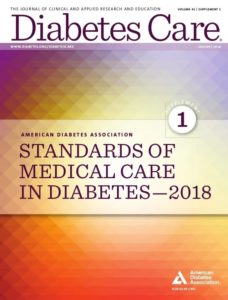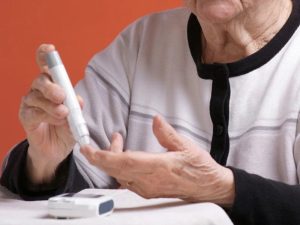
For diabetes healthcare workers, part of ringing in the new year is reviewing the American Diabetes Association (ADA) Updated Diabetes Standards of Medical Care. Each year, a professional practice committee reviews evidence that has come out since the previous edition, providing recommendations for best practices in diabetes care. For those who have not yet had a chance to review the 2018 Standards, here is the cliff notes version, particularly as the updates relate to Certified Diabetes Educators (CDEs).
The first update relates to the Standards of Care document overall. While this document will continue to be updated annually, there will now be an online version that is updated more frequently as needed (Professional.diabetes.org/SOC). In addition, the ADA will begin accepting proposals from the community for statements, consensus reports, scientific reviews, etc. CDEs would benefit from this opportunity to suggest topics for in-depth review that will further the evidence related to our effective support for patient self-management. The Standards of Care includes 15 chapters, to provide a comprehensive overview of evidence-based management of diabetes. While there are no major changes in the 2018 version, there are minor updates worth noting.
Chapter 1 of the document, previously entitled ‘Strategies for Improving Care’, has been renamed ‘Promoting Health and Reducing Disparities.’ This chapter includes a new recommendation that providers consider the burden of treatment and the self-efficacy of patients when recommending treatments. This chapter also discusses the importance of tailoring diabetes treatment for the social context of the patient. Individuals should be assessed for factors such as housing stability, food insecurity, and finances, all of which have a huge impact on patient self-management. Importantly, this chapter encourages providers to refer to community resources including diabetes self-management education services (hooray, CDEs!), as well as to community health workers.
Chapter 2 covers classification and diagnosis of diabetes. A slight change in this section is that although the ADA has historically not recommended community screening, now the organization states that screening should be considered, as long as there is a referral system in place for patient follow up. There was no change in the criteria for diagnosis of pre-diabetes or diabetes. However, the standards do highlight the limitations in the use of A1C for diagnosis in certain populations with conditions in which the red blood cell turnover is more rapid. Plasma glucose levels should be used instead of A1C in patients with sickle cell disease, pregnancy, on hemodialysis, etc. There was no change for testing in asymptomatic adults, but there is an update regarding risk-based screening for children and adolescents. Overweight individuals younger than 18 years old who have one additional risk factor should be screened for diabetes, whereas previous guidelines required 2 other risk factors.
Chapter 3 discusses comprehensive evaluation and assessment. This section includes new verbiage regarding the importance of the language that we use with and about our patients. Providers are encouraged to use “patient-centered and strength-based language” (ex. Avoid using the term ‘diabetic’), and to focus on what the person does well rather than emphasizing what they don’t currently do. Table 3.1 is a newly organized summary of the components of the comprehensive diabetes evaluation. This table includes a new section recommending assessment of patients’ use of technology (health appts, online education, CGM results, etc.). Importantly, this table also includes a section on DSME and support (history of visits with a diabetes educator, barriers to DSME, refer to local resources and support).

Chapter 4 is a summary of lifestyle interventions for diabetes. This essential chapter does not have any substantial changes, although new references are included that will benefit CDEs planning diabetes presentations this year. There is a specific recommendation for 4 critical times for diabetes education: at diagnosis, annually, when complicating factors arise, and when there are transitions in care. This year there is added verbiage that DSME can be in group, individual, or using technology.
The standards continue to have no specific percentage recommendations for any nutrient. Rather, they emphasize individual assessment and meal planning, and working toward overall healthful eating patterns. The physical activity section also has no changes after being extensively updated last year. Children should engage in at least 60 minutes per day of moderate to vigorous activity and adults should get at least 150 minutes per week. Conversely, prolonged sitting should be interrupted every 30 minutes, particularly for those with type 2 diabetes. Lastly, the section on psychosocial issues also does not contain any updates. Table 4.2 is a valuable summary of when to refer to mental health care.
Chapters 5 and 6 have no major updates.

Chapter 7 discussed the management of obesity, and this section was updated to include potential cost information for obesity medications. While not possible to provide information regarding the actual cost to consumers, the National Average Drug Acquisition Cost prices were added to give an idea of cost relative to other options. The medication Phentermine was added as short-term treatment options for obesity.
Chapter 8 focuses on pharmacologic treatment for diabetes. The algorithm has changed this year, based on new evidence regarding cardioprotective effects of certain medications. If patients are not reaching goal with metformin and lifestyle intervention, the medication decision tree is based on whether they have established atherosclerotic disease (ASCVD). If so, providers are guided to add specific medications that reduce risk. Empagliflozin (Jardiance) and Liraglutide (Victoza) are assigned level A evidence regarding lowered risk of CV events and mortality, and Canagliflozin (Invokana) is assigned level C evidence in this regard.
Chapter 9 further discusses cardiovascular disease and risk management. This section has substantial changes this year. One relevant change for CDEs is that all hypertensive patients should be advised to self-monitor at home, in order to identify white coat hypertension. For prescribing providers, this chapter includes a hypertension treatment algorithm for patients with diabetes, depending on blood pressure at diagnosis. Chapter 9 also includes a simplified approach to prescribing statins.
Chapter 10 covers microvascular complications, with a new section added about acute kidney injury. CDEs should continue to talk to patients about use of NSAIDS, especially those that are taking ACE inhibitors or ARBS to control blood pressure. In addition, patients should be encouraged to discuss with their provider the supplements and herbs that they are using, often times for diabetes management, in order to avoid damage to the kidneys. This chapter also includes data regarding the kidney protective effects of diabetes drugs.

Chapter 11 includes new recommendations regarding older adults: to avoid over treatment, reduce the risk of hypoglycemia, and simplify complex regimens if possible. There continues to be evidence regarding the risks and sequelae from hypoglycemia, and recognition that elderly patients are most at risk for these complications.
The remainder of the Standards of Care document contains information regarding diabetes care for special populations, as well as recommendations for diabetes advocacy. By staying up to date with current evidence, even if largely unchanged, CDEs can continue to represent the profession with confidence. We bring the knowledge of science, combined with the art of human connection, to change lives and improve heath.
Salud!
Andrea Zurawski RN, CDE
Certified Diabetes Educator at Cecelia Health
Reference:
Maryniuk, M and Neumiller, J. (2018). 2018 ADA Standards of Medical Care in Diabetes. Recorded webinar, American Association of Diabetes Educators.
